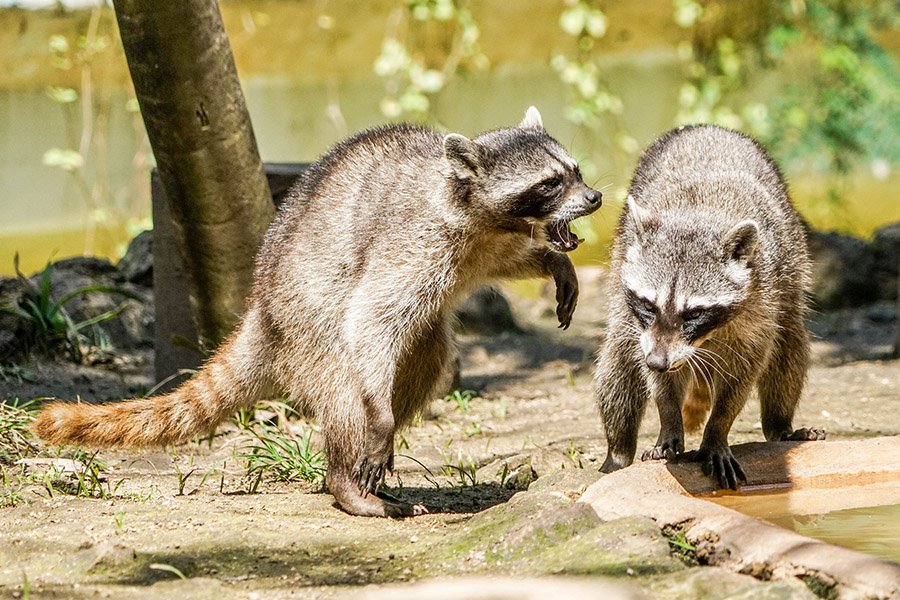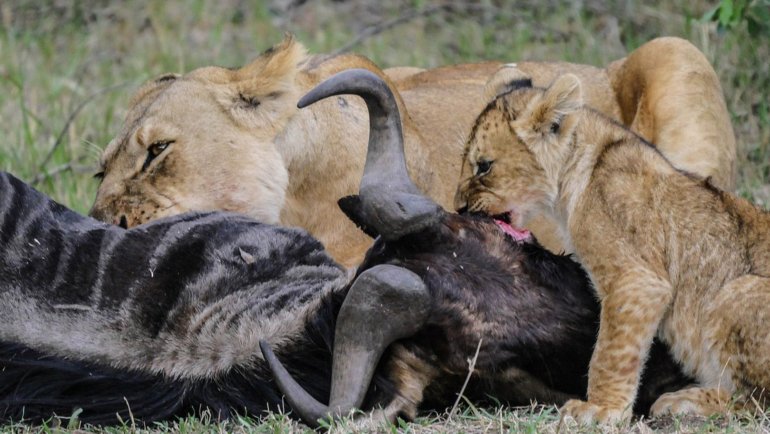Raccoons are known to be solitary creatures and often avoid confrontations with each other. However, like any other animal, they can occasionally engage in fights.
Therefore, this article aims to explore in detail why raccoons fight with each other and when this activity takes place while highlighting other vital facts related to these mammals’ behavior.
Why Do Raccoons Fight?
1. Territory
Raccoons fight for territory for these few key reasons:
Firstly, raccoons need a specific territory to ensure that they have ample access to food, water, and shelter. After establishing a suitable habitat, they typically defend their territory by all means possible such as fighting off invading raccoons in order to protect the available resources.
Secondly, raccoons are social animals but prefer to live in small family groups rather than large colonies. Therefore, each raccoon needs enough space to live, hunt, and raise their young without interference from other raccoon families.
Finally, raccoons are territorial because they want to attract mates and reproduce. Males often fight with other males to establish dominance and gain access to females, while females defend their territory from other females to ensure that they have enough resources to raise their young.
Overall, territorial behavior is essential for these species to survive and thrive in their environment, as it allows them to access resources, establish social structures, and reproduce successfully.
2. Food
Since food can be scarce in the wild, and competition for resources can be fierce, raccoons may fight for the available resources in order to gain an advantage over their competitors and enhance their survival.

Additionally, raccoons are territorial animals and may see a food source as belonging to them, which can lead to aggression towards other raccoons that try to access the same food.
It’s also important to note that raccoons, like many other animals, have the instinct to compete for resources. This instinct has developed over time as a survival mechanism. It helps to ensure that the strongest and fittest individuals can secure the resources they need to survive and reproduce.
3. Mating
Like many other animals, raccoons fight to establish dominance and secure a mate during mating season. This season typically occurs in late winter or early spring, and during this time, males will actively seek out females in order to mate and pass on their genes to the next generation.
Since it’s common for the males to be more than the fertile females, male raccoons will frequently fight with each other to compete for access to the receptive females, as the winners of these fights are more likely to be chosen as mates.
These fights can be aggressive and may involve biting, scratching, and vocalizing. Male raccoons may also use scent markings and vocalizations to establish dominance and attract females.
4. Hierarchical Disputes
Raccoons are known to have a hierarchical social structure, with dominant individuals occupying higher ranks in the group. They fight for the hierarchy mainly due to competition for resources, such as food, shelter, and mating opportunities.

In a raccoon group, dominant individuals have access to the best resources and are more successful in reproducing and passing their genes to the next generation.
Therefore, subordinate raccoons may try to challenge the dominant individuals for higher ranks in the group, as it can improve their chances of survival and reproduction.
Overall, the hierarchical social structure in raccoons serves as a way to regulate competition for resources and ensure the survival and reproductive success of the individuals in the group.
5. Protecting Their Offspring
Like many other animals, raccoons invest significant time and energy into raising their young. Female raccoons give birth to litters of kits born blind, deaf, and utterly dependent on their mother for survival.
The mother raccoon will nurse her young for several weeks until they are strong enough to venture out of the den and begin exploring their surroundings.
During this time, the mother raccoon is very protective of her young and will defend them against any perceived threats, whether predators, other raccoons, or humans. It is because the survival of her offspring is crucial to the species’ survival.
6. Sick with Rabies
Raccoons infected with rabies may exhibit aggressive behavior, including fighting with other raccoons and biting for no reason. It’s because rabies is a viral disease that attacks the nervous system and can cause the affected animal to become disoriented, aggressive, and unpredictable.
When Do Raccoons Fight?
Raccoons are typically nocturnal animals which means they are primarily active at night. It explains why most of their fights occur at night.
Raccoons may also fight each other during certain times, particularly during the mating season, which typically occurs in late winter and early spring.
Male raccoons usually become more aggressive and hostile toward each other as they compete for female mates. This factor occasionally leads to fights between the competing mammals in an attempt to emerge as the winner who’ll secure the breeding rights.
Additionally, raccoons may fight over food sources, especially if resources are scarce in the wild. It can also happen in urban areas where food is easily accessible in trash cans, especially when rival raccoon families meet at the same spot.
Frequently Asked Questions
Why Do Raccoons Fight in Trees?
Fighting in trees is a natural behavior for raccoons and is often used to establish dominance and safeguard their territory. In this vegetation, they can use their sharp claws and teeth to attack/defend their opponent by pushing them off the tree branch or trunk to gain an advantage.
Furthermore, fighting in trees provides these mammals with a safer environment than on the ground. Trees provide cover from predators and may be a safer means of escape for a raccoon losing a fight.
Do Raccoons Fight To The Death?
While fights between raccoons can be intense and can lead to severe injuries, they rarely fight to the death. In general, raccoons are more likely to try to intimidate each other through displays of aggression, such as growling, hissing, or arching their backs.
If a fight does occur, it typically involves biting, scratching, and grappling, but one of the raccoons will usually retreat if it becomes too injured, exhausted, or defeated.
Are Raccoons Territorial?
Yes, raccoons can be territorial animals, especially during the mating season. Adult male raccoons are more likely to be territorial than females, and they will defend their territory against other males.
However, raccoons may also share a common area if there is an abundance of resources such as food and shelter. While raccoons can be territorial, their behavior can vary depending on various factors such as resource availability, population density, and mating season.
What Does it Mean When a Raccoon Stands Up?
A raccoon is naturally a curious and intelligent animal; hence when it stands up on its hind legs, it is usually trying to get a better view of its habitat, assess potential threats or predators, or gain a better sense of its surrounding environment.
Final Thoughts
Despite being peaceful mammals that always try their best to avoid confrontations or fights among themselves and other animals, it’s essential to note that they are still wild animals.
Therefore, the rule of the jungle, survival of the fittest/strongest, also applies to them. As a result, raccoons will occasionally fight for the reasons stated above.


